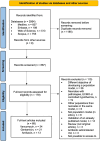A Review of Vancomycin, Gentamicin, and Amikacin Population Pharmacokinetic Models in Neonates and Infants
- PMID: 39821208
- PMCID: PMC11762427
- DOI: 10.1007/s40262-024-01459-z
A Review of Vancomycin, Gentamicin, and Amikacin Population Pharmacokinetic Models in Neonates and Infants
Abstract
Population pharmacokinetic (popPK) models are an essential tool when implementing therapeutic drug monitoring (TDM) and to overcome dosing challenges in neonates in clinical practice. Since vancomycin, gentamicin, and amikacin are among the most prescribed antibiotics for the neonatal population, we aimed to characterize the popPK models of these antibiotics and the covariates that may influence the pharmacokinetic parameters in neonates and infants with no previous pathologies. We searched the PubMed, Embase, Web of Science, and Scopus databases and the bibliographies of relevant articles from inception to the beginning of February 2024. The search identified 2064 articles, of which 68 met the inclusion criteria (34 for vancomycin, 21 for gentamicin, 13 for amikacin). A one-compartment popPK model was more frequently used to describe the pharmacokinetics of the three antibiotics (91.2% vancomycin, 76.9% gentamicin, 57.1% amikacin). Pharmacokinetic parameter (mean ± standard deviation) values calculated for a "typical" neonate weighing 3 kg were as follows: clearance (CL) 0.34 ± 0.80 L/h for vancomycin, 0.27 ± 0.49 L/h for gentamicin, and 0.19 ± 0.07 L/h for amikacin; volume of distribution (Vd): 1.75 ± 0.65 L for vancomycin, 1.54 ± 0.53 L for gentamicin, and 1.67 ± 0.27 L for amikacin for one-compartment models. Total body weight, postmenstrual age, and serum creatinine were common predictors (covariates) for describing the variability in CL, whereas only total body weight predominated for Vd. A single universal popPK model for each of the antibiotics reviewed cannot be implemented in the neonatal population because of the significant variability between them. Body weight, renal function, and postmenstrual age are important predictors of CL in the three antibiotics, and total body weight for Vd. TDM represents an essential tool in this population, not only to avoid toxicity but to attain the desired pharmacokinetic/pharmacodynamic index. The characteristics of the neonatal population, coupled with the lack of prospective studies and external validation of most models, indicate a need to continue investigating the pharmacokinetics of these antibiotics in neonates.
© 2025. The Author(s).
Conflict of interest statement
Declarations. Conflict of Interest: The authors report no conflicts of interest. Ethical Approval: Not applicable. Consent to Participate: Not applicable. Consent for Publication: Not applicable. Availability of Data and Materials: Not applicable. Code Availability: Not applicable Author Contributions: MAF contributed to the conception and design of the study, data search, extraction, and interpretation and to the drafting of the manuscript. CB contributed to the conception and design of the study, methodology assessment, data interpretation, supervision, and revision of the manuscript. MRR and DSM contributed amendments to the manuscript and revised it critically.
Figures
Similar articles
-
A Retrospective Review of the Efficiency of First-Dose Therapeutic Drug Monitoring of Gentamicin, Amikacin, and Vancomycin in the Pediatric Population.J Clin Pharmacol. 2020 Jan;60(1):7-15. doi: 10.1002/jcph.1509. Epub 2019 Aug 25. J Clin Pharmacol. 2020. PMID: 31448430
-
Developmental pharmacokinetics of gentamicin in preterm and term neonates: population modelling of a prospective study.Clin Pharmacokinet. 2009;48(4):253-63. doi: 10.2165/00003088-200948040-00003. Clin Pharmacokinet. 2009. PMID: 19492870 Clinical Trial.
-
Population pharmacokinetics of vancomycin and AUC-guided dosing in Chinese neonates and young infants.Eur J Clin Pharmacol. 2018 Jul;74(7):921-930. doi: 10.1007/s00228-018-2454-0. Epub 2018 Mar 30. Eur J Clin Pharmacol. 2018. PMID: 29602981
-
A review of population pharmacokinetic models of gentamicin in paediatric patients.J Clin Pharm Ther. 2019 Oct;44(5):659-674. doi: 10.1111/jcpt.12850. Epub 2019 May 17. J Clin Pharm Ther. 2019. PMID: 31102287 Review.
-
Pharmacokinetics and Target Attainment of Antibiotics in Critically Ill Children: A Systematic Review of Current Literature.Clin Pharmacokinet. 2020 Feb;59(2):173-205. doi: 10.1007/s40262-019-00813-w. Clin Pharmacokinet. 2020. PMID: 31432468 Free PMC article.
References
-
- Marsot A, Boulamery A, Bruguerolle B, Simon N. Population pharmacokinetic analysis during the first 2 years of life: an overview. Clin Pharmacokinet. 2012;51(12):787–98. - PubMed
-
- Chung E, Sen J, Patel P, Seto W. Population pharmacokinetic models of vancomycin in paediatric patients: a systematic review. Clin Pharmacokinet. 2021;60(8):985–1001. - PubMed
Publication types
MeSH terms
Substances
LinkOut - more resources
Full Text Sources
Medical
Miscellaneous


